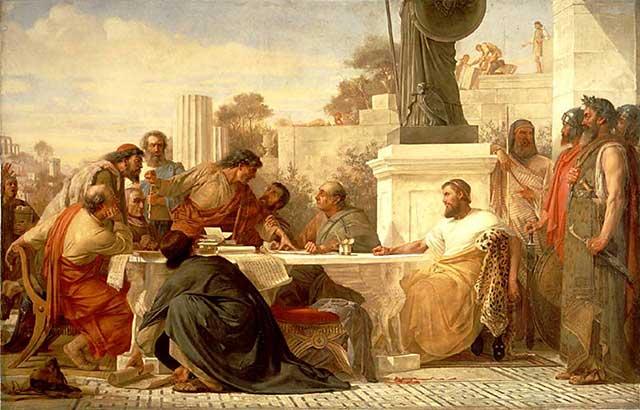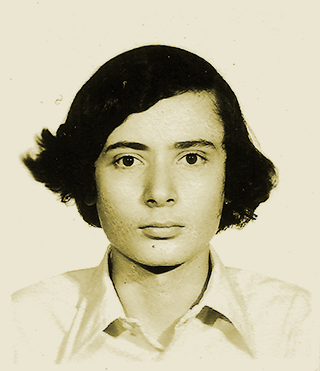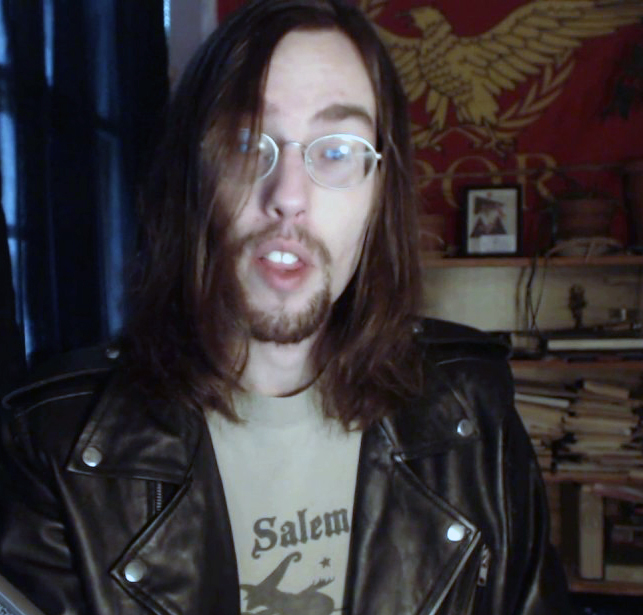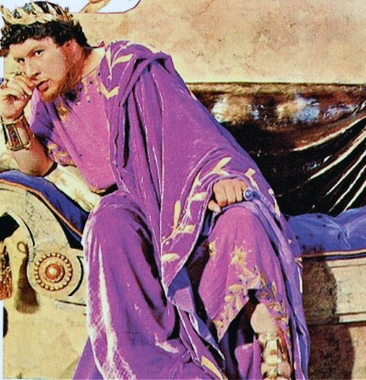by Matt Koehl
V. The Tragedy of 1945
 The fall of Berlin to the Eastern hordes in 1945 represents a decisive turning point in the history of the world. Very few have yet grasped its real import, although many have argued the hypothetical possibilities of a different denouement to that fateful conflict. Unfortunately, the scenario was predetermined and involved elements which even superhuman agency could not contain or overcome.
The fall of Berlin to the Eastern hordes in 1945 represents a decisive turning point in the history of the world. Very few have yet grasped its real import, although many have argued the hypothetical possibilities of a different denouement to that fateful conflict. Unfortunately, the scenario was predetermined and involved elements which even superhuman agency could not contain or overcome.
The events of 1945 were in fact, but the concluding scene of a great tragic drama which began on April 20, 1889, when a very remarkable figure made his appearance in this world to herald the start of the second half of human history. But although the birth of this extraordinary personality signals the beginning of a new age, his earthly work was constrained by exigencies under an Old Order.
And it is here that the element of tragedy is introduced. For he came into the world during a historical cusp—during the period when one order is dying and another has yet to be born—which foredoomed all of his finest efforts and precluded the possibility of a fulfillment of his Idea during his mortal lifetime.
It is perhaps the greatest of historical ironies that it was Adolf Hitler, the father of a new age, who offered the West its last opportunity for resuscitation and renewal. By infusing new spirit into the old civilization and by defending its major institutional forms—as the Führer proposed—it is conceivable that the Old Order might have been able to protract its historical life, perhaps even for another millennium.
It was not to be, however. The decay was too advanced. In its diseased and delirious condition, the West rejected the one hand which could have rescued it from impending death.
Beyond that, however, the contradiction between the values of the Old and the New was simply too great. In the final analysis, these values were mutually exclusive. And so the Second World War was, in fact, a “war against the West,” as critics of National Socialism have charged. It represented a titanic struggle between the Old and the New. Unfortunately, the entrenched forces of the Old—even in their decadent and moribund state—proved momentarily too formidable for the incipient New.
It must be noted here—and this is not without significance—that the Third Reich, the provisional state of the New, was itself heavily and fatally infected by ideas and elements carried over from the Old. The New had not completely prevailed against the Old. For that it had hardly had time; in fact, it had barely begun. The very nature of its introduction, which was dictated by the political and social realities of contemporary Germany, involved a gradual, evolutionary transition from the Old to the New, rather than violent upheaval—something which would have been neither feasible nor justifiable under existing historical circumstances.
In consequence, however, we find that by the outbreak of war in 1939, old thinking, old attitudes, old habits and old interests continued to persist in many quarters of German society. The new ways were still far too tenuous. Not even the space of a single generation had been granted for the introduction of necessary radical change, with the result that the new thinking and new attitudes which could have produced the extra margin of revolutionary morale to effect a different sequel never had an opportunity to develop properly.
Thus, the outcome of this tragic drama could not have been other than what it was. Fate had chosen the time and the place and had set the stage, and events proceeded in their appointed manner. Yet even this cataclysmic tragedy—with the immolation of its godlike protagonist and his martyr people—was historically necessary for two reasons:
- First, it resulted in a decisive blow to the Old Order, a mortal blow from which it can never recover and which assures its disappearance from the stage of world history; and
- Secondly, by clearing the field, it has served to release the new Movement from any lingering constraints, inhibitions or commitments with respect to the Old—thus enabling it to acquire the necessary freedom for the fulfillment of its revolutionary mission. This is particularly important to consider, for not only was 1945 a watershed in the larger history of the world; it was a great divide in the development of the Movement as well. A phase which had been essentially political and military now became spiritual—yes, even religious.
Militarily and politically, National Socialism stood defeated in 1943—completely. Had it represented merely a political or military structure, it could not have survived the collapse. The Idea of Adolf Hitler, however, was more than just political or military. It was above all spiritual—and spiritual ideas cannot be broken by brute force or military means alone. And yet, military might and physical compulsion were the only resources at the disposal of the Old Order, morally and spiritually it was bankrupt. And so its apparent defeat of National Socialism in reality proved to be something quite different.
For in the contest, the new Idea had lost none of its integrity—its inner substance—but remained spiritually undefeated, awaiting only the proper moment to make its reappearance. Indeed, it was precisely in this vital area that it proved itself stronger than ever.
Unimpeded by expedient—i.e., political—considerations of any kind, it was now completely free and unfettered to pursue its high destiny. Out of the crucible of the most horrible suffering and hardship, a Movement had emerged—inwardly purged, perfected in its faith, fortified, steeled and infinitely more conscious of its holy mission on this earth.
As we now move further into the future, we begin to perceive the faint outline of an awesome design: Adolf Hitler and his people had to sacrifice themselves so that the wonderful, new Idea could one day be reborn in exalted form as a glorious beacon and symbol for embattled Aryan mankind everywhere.
That was the purpose and essence of their heroic, Olympian struggle. And it is now upon this sacred foundation—one forged and hallowed in the flames of monumental tragedy—that a regenerate Movement must build, and in so doing give eternal meaning to the precious blood sacrifice of those martyred millions, representing a higher humanity, who fell with the faith of a new age in their hearts.




